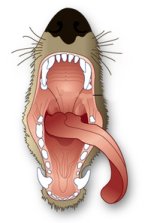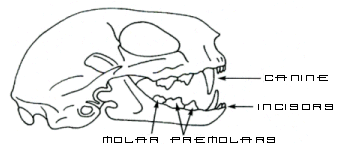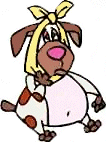|

DOG
DENTAL FACTS
 Puppies have 28 temporary teeth that erupt at about three to four weeks of age. They have 42 permanent teeth that begin to emerge at about four months of age. Puppies have 28 temporary teeth that erupt at about three to four weeks of age. They have 42 permanent teeth that begin to emerge at about four months of age.
Puppies should lose a puppy tooth before the corresponding adult tooth emerges. If a puppy tooth is still in place when an adult tooth begins to show, see your veterinarian so the dog's occlusion is not affected.
Studies show that by age three, 80 percent of dogs exhibit signs of gum disease. Symptoms include yellow and brown build-up of tartar along the
gumline, red inflamed gums and persistent bad breath.
Small dog breeds are more likely to develop periodontal disease than large dogs because the teeth of small dogs are often too large for their mouths, according to veterinary dentistry experts.
The canine teeth of working dogs are essential to allowing the dogs to carry prey and other objects. If these teeth become broken, a canine dentist can prepare a metal crown.
A broken tooth is a common problem, especially among outdoor dogs. Aggressive chewing on hard objects, such as cow hooves, is a primary cause, according to veterinary dental experts.
Number of
Deciduous Teeth |
Number of
Permanent Teeth |
Age at Eruption
of Deciduous Teeth |
Age at Eruption
of Permanent Teeth |
28
• 14 upper
• 14 lower |
42
• 20 upper
• 22 lower |
3-8 weeks |
12-26 |
View Dental Chart - Click here

TYPES OF
TEETH
Mammalian carnivores have teeth that line the upper and lower jaws. There are four types of teeth with different functions:
Incisors: cutting and nibbling food
Canine teeth: holding and tearing food
Premolars: cutting, holding, and shearing food
Molars: grinding food
Numbers of teeth
Many mammals, including dogs, cats, and ferrets are "diphyodont" meaning they have two sets of teeth, one set (called "deciduous") being shed and replaced by a permanent set. Although the exact number can vary, puppies have 28 deciduous (temporary) teeth, and adult dogs have 42 permanent teeth. Feline kittens have 26 deciduous teeth, and adult cats have 30 permanent teeth. Ferret kits have 30 deciduous teeth, with adults having 34.
Tooth eruption
In kittens and puppies, the deciduous teeth begin to erupt at about 3-4 weeks of age and the permanent teeth begin to emerge at about 3-4 months of age. By 24 weeks of age, usually all of the permanent teeth have emerged.
|
|

ESTIMATING AGE IN THE CANINE
Examining teeth is one of the best ways to determine the approximate age of a dog. Look at the degree of growth to determine the ages of
puppies, and look at the degree of wear to determine the ages of adult dogs. The diagram and chart below can help.
Be aware of two things that can throw off your estimates. First, an animal who has received dental care will have better looking teeth than an animal who has not received such treatment. Second, variations exist among animals, even two from the same litter. Teeth are only a rough indicator of any animal's actual age.
Teeth are anchored in sockets on both upper and lower jaws and inside are supplied with nerves. Teeth are of several sorts, each shaped for handling different sorts of food. Basically teeth comprise two incisors (for cutting and slicing) at the front on each side of the upper and lower jaws. (This means four upper and four lower incisors). Behind the incisors on each side there is a canine tooth (for piercing, stabbing and holding); thus there are four canines. Behind the canines are two premolars and two molars all of which are shaped for grinding and chewing.

|
Estimated
Age
|
Teeth Development
|
| 2 - 4
Weeks |
No
Noticeable tooth growth
|
| 3 - 4
Weeks |
Deciduous
(baby) canines coming in
|
| 4 - 6
Weeks |
Deciduous
(baby) incisors and premolars coming in
|
| 8 Weeks |
All
deciduous (baby) teeth are in
|
| 3 1/2 -
4 Months |
No
noticeable permanent tooth growth
|
| 5 - 7
Months |
Permanent
canines, premolars, and molars coming in; all teeth in by 7 months
|
| 1 Year |
Teeth
white and clean
|
|
1 - 2
Years |
Teeth
may appear dull with some tartar build-up (yellowing) on back teeth
|
| 3 - 5
Years |
Teeth
show more tartar build-up (on all teeth) and some tooth wear
|
| 5 - 10
Years |
Teeth
show increased wear and disease
|
| 10 - 15
Years |
Teeth
are worn and show heavy tartar build up; some teeth may be missing
|

ABNORMALITIES
|
What is meant by the words overbite, open bite, overjet, level bite, overshot, underbite, anterior crossbite, wry bite, lingually displaced or base narrow canines?
Anatomy
Dogs normally have 28 deciduous (primary or baby) teeth that erupt during the first six months of life. Most breeds have 42 adult teeth. Cats have 26 deciduous and 30 adult teeth. There are four types of teeth. Incisors are the smaller teeth located between the canines on the upper and lower jaws.
They are used for grasping food and help keep the tongue within the mouth. Canines (also called cuspids or fang teeth) are located on the sides of the incisors and used to grasp food. Premolars (bicuspids) are for shearing or cutting food and are located behind the canines. The molars are the last teeth in the mouth. They are used for grinding nourishment for entry into the esophagus.
The way teeth align with each other is termed occlusion. Normal occlusion in most medium and long-nosed breeds consists of the upper (maxillary) incisors just overlapping the lower (mandibular) incisors (scissor bite). The lower canine should be located equidistant between the last (lateral) incisor and the upper canine tooth. The premolar tips of the lower jaw should point between the spaces of the upper jaw teeth.
Malocclusion
Malocclusion refers to abnormal tooth alignment. (click here
for further info on selected canine maloclusions)
Overbite (overshot, class two, overjet, mandibular brachygnathism) occurs when the lower jaw is shorter than the upper. There is a gap between the upper and lower incisors when the mouth is closed. The upper premolars are displaced at least 25 percent toward the front when compared to the lower premolars. Both over and undershot jaws are relatively common.
An underbite (undershot, reverse scissor bite, prognathism, class 3) occurs when the lower teeth protrude in front of the upper jaw teeth. If the upper and lower incisor teeth meet each other edge to edge, the occlusion is an even or level bite. When the upper and lower incisors do not overlap or even meet each other when the mouth is closed, the pet has an open bite.
Anterior crossbite occurs when the canine and premolar teeth on both sides of the mouth occlude normally, but one or more of the lower incisors are positioned in front of the upper incisors. Anterior crossbite is the most common malocclusion, is not considered genetic or hereditary and is correctable.
Posterior crossbite occurs when one or more of the premolar lower jaw teeth overlap the upper jaw teeth. This is a rare condition that occurs in the larger-nosed dog breeds.
A wry mouth or wrybite occurs when one side of the jaw grows longer than the other, causing it to bend to one side resulting in malocclusions of the teeth in the front of the jaw. This is sometimes hard for people who haven't seen it to envision. Move your own jaw from side to side. Put it to one side and hold it there.. (Remember that a dog does not have lateral movement in its jaws as we do.) This is wry mouth.
Lingually displaced mandibular (base narrow) canines occur when the mandibular canine teeth protrude inward causing penetrating damage to the upper palate. This condition is due to either persistent primary teeth or a too-narrow mandible and can usually be corrected through an orthodontic appliance (inclined plan) used to direct the teeth into normal occlusion.
|
|
Rostrally deviated canine teeth occur when the maxillary or mandibular canine is directed forward and can usually be corrected by orthodontic movement, crown reduction or extraction.
Missing/Extra Teeth. Dogs will lack one or more teeth, usually pre-molars. Sometimes there will be an extra pre-molar or molar.
Dropped Centre Incisors. The two centre lower incisors will be shorter than the others. Sometimes they will tip forward giving the illusion of a level or slightly undershot bite when viewed from the side.
It is not recommended to breed a dog with an over, under or wry mouth. The jaw is deformed and obviously the dog is carrying defective genes. Breeding a dog with these problems is a guarantee that you are giving a significant dose of those genes to its offspring. (Rather like breeding a dog you know is dysplastic.) If an unaffected dog produces multiple affected offspring, particularly from different and unrelated mates, you should withhold that dog from further breeding. Do not repeat breedings that produce these defects. The parents and siblings (full and half) should not be bred to near relatives and should only be bred to mates from families where the fault in question is not a problem.
LDC.

Canine Teeth ::
Page 3 :: Page
4 :: Page
1 ::
Click here to see the
article Selected Canine Malocclusions
View Dental Chart - Click here

|
LINKS TO CANINE
TEETH & GUM PROBLEMS:
|
|
|

| Retained Deciduous Teeth | Caring
For Your Löwchens Teeth | Dog Dental Facts |
| Types of Teeth |
Canine Malocclusions | Estimating Age in the Canine |
| Abnormalities of the Canine Mouth |
Dental Chart | Canine Dental Links |

|
|
 Puppies have 28 temporary teeth that erupt at about three to four weeks of age. They have 42 permanent teeth that begin to emerge at about four months of age.
Puppies have 28 temporary teeth that erupt at about three to four weeks of age. They have 42 permanent teeth that begin to emerge at about four months of age. 
